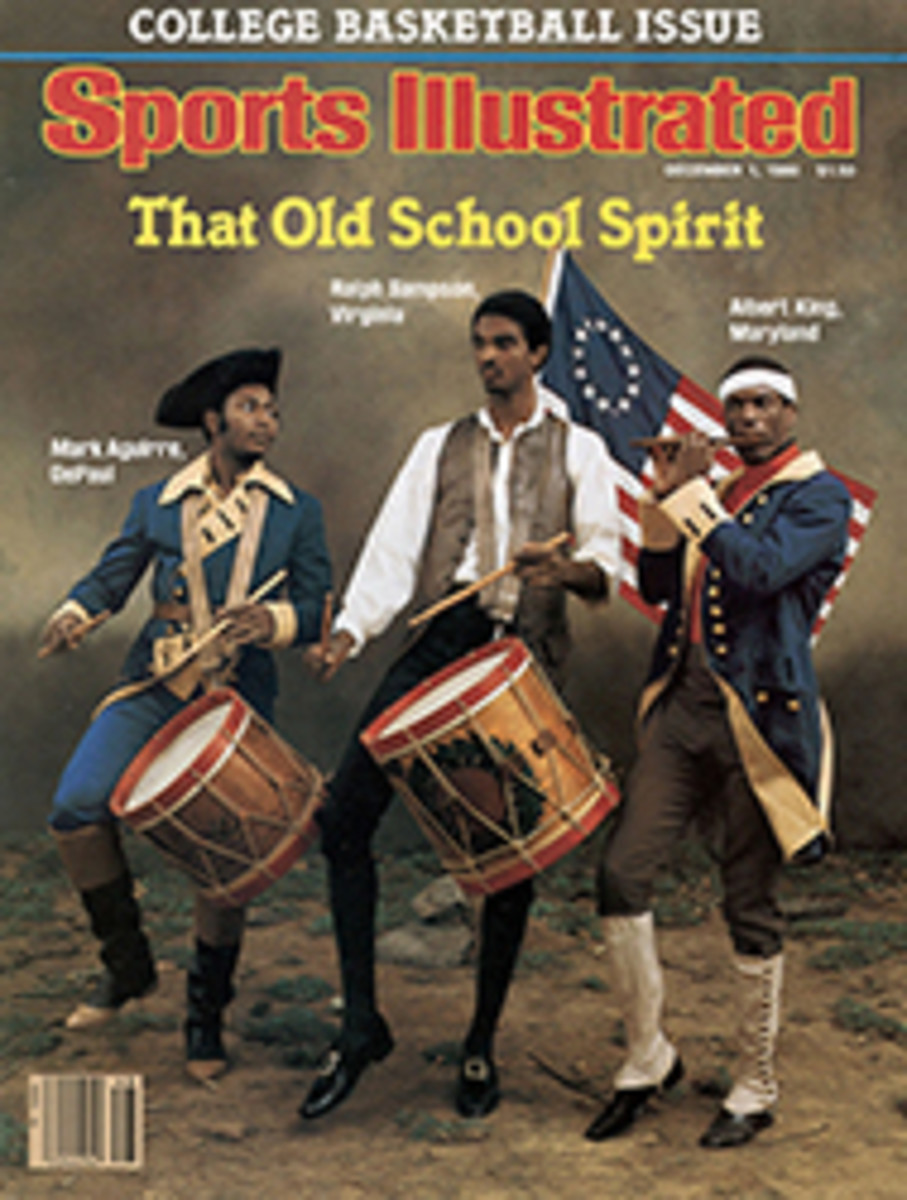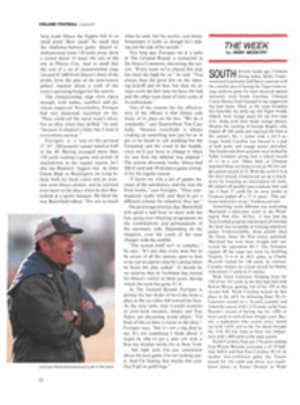
IT'S TIME FOR TRIMMING SAILS IN THE NASL
When the owners of the 24 NASL teams meet in Chicago on Dec. 1, the atmosphere in the O'Hare Hilton will be distinctly gloomy. For a change, the league's VIPs won't be hearing any talk of blue skies and rosy futures from Commissioner Phil Woosnam. No onward and upward message this time. The mood of uncertainty included the question of whether Board Chairman Henry Kissinger would show up. The fact is that the league is taking a pounding such as it has never experienced in a decade of heady expansion. The pounders include a militant union, a federal court, the U.S. Immigration and Naturalization Service and a television network. The ledger books reveal an absolute torrent of red ink. Before the Chicago meetings are over, two and perhaps three teams will have been swept away.
Every one of the 24 franchises is believed to have lost money this year, with the across-the-league deficit amounting to about $30 million. Although attendance was up 7% over 1979 (to 6,196,000), the prospects for 1981 are the worst since 1969, when the league had shrunk to five teams and no one thought it would survive. Is the situation really that bleak? Well, the league will survive—but there will be scars.
The biggest crack in the league's image and credibility may become visible as early as the first day of the meetings, at which time the Madison Square Garden Corporation (which is owned by Gulf & Western) is expected to return its certificate of ownership of the Washington Diplomats to Woosnam. When a well-heeled, corporate-backed club in a prestigious city decides to fold, that's trouble. Although Washington is a potentially lucrative market—and average attendance rose to 19,204 last summer from 11,973 in 1979—the franchise has lost $2½ million in the two years MSG has owned it. MSG President Sonny Werblin cites the recession, bigger operating expenses and a geometrical leap in acquisition costs and salaries for players. Dutch star Johan Cruyff, a big gate attraction, alone commands $500,000 per year.
Neither the Houston Hurricane nor the Rochester Lancers have posted their $150,000 annual performance bonds with the NASL. They face an "Involuntary Termination" hearing in Chicago. "We couldn't go on much longer, anyway," says Lancer President Pat Dinolfo. A deal to sell the Hurricane to investors assembled by the California-based Athletes In Action, a religious group, fell through, and Houston's fate is expected to be the same as Rochester's.
Nor could what happened to the Minnesota Kicks in the off-season give the owners much cause for cheer. For years during the league's upward surge, the Kicks, owned and vigorously promoted by a group of Minnesota food executives, were one of NASL's showcase teams, successful on the field and second only to the Cosmos in attendance. But last season the team sagged, and so did attendance; three weeks ago the Minnesotans sold out, and the Kicks are now owned by a British group.
And the NASL's relocation game has resumed. The Memphis Rogues are now the Calgary Boomers, owned by Nelson Skalbania, the Canadian sports entrepreneur. The Philadelphia Fury moved to Montreal, with the Molson Brewery as its new proprietor. And Lipton's Teamen, unable to settle scheduling and parking disputes with Schaefer Stadium in Foxboro, Mass., have become the Jacksonville, Fla. Teamen.
The net effect of these failures and transfers is to leave the league with only two teams, Atlanta and the Cosmos, the latter perched outside New York in the New Jersey Meadowlands, on the East Coast between Montreal and Jacksonville—a truly gigantic void.
But embattled owners are adamant about cutting their losses and regrouping. Clive Toye is president of the Toronto Blizzard and has been a pal of Woosnam's from early NASL days. "It's not like 1969, when no owner had success or saw any hope," he says. "Now we've gained a beachhead, but it's a tangled one. To put it simply, we bit off more than we could chew when we expanded from 18 to 24 teams in 1977. We all spent too much on players without a parallel jump in fan appeal or the quality of the game. We're paying the price now. The price is contraction."
The tide of owner opinion has now turned against weak sisters. Bob Bell is a commodities broker who has poured $5 million into the San Diego Sockers in the past two years. "It's sink or swim. We're not a socialist group, we're businessmen," he says. "If an owner can't make it, we won't go to the well for him any longer." Jack Daley, president of the Seattle Sounders, is equally hard-nosed. "After the novelty of owning a sports team wears off, it's a bottom-line business," he says. "If your car dealership fails, you close up. It's the same in the NASL now."
Somewhat surprisingly under the circumstances, the league's many problems haven't produced a coherent anti-Woosnam movement. The Welsh-born commissioner, who was the eloquent apostle of expansion, has been regarded as vulnerable to a what-we-need-now-is-a-hardheaded-American attack. While Seattle's Daley is often mentioned as a possible successor, insiders believe that Woosnam is sufficiently sensitive to the owners' new mood to turn from super-salesmanship to retrenchment. Says one owner, "Phil's duties will be changing. He'll be a consolidator, not a front man."
In his New York office Woosnam broods, but because it's his nature to do so, he broods optimistically. "We're not an automatic success story," he says. "But it took the NFL 40 years to get to where it was in 1960, which is about our level now. We've done it in 14 years. This, however, is the year of realism. The phrase is steady and slower."
Compared to the basic cashbox problem, Woosnam's other difficulties are less daunting. Take the labor dispute. The NASL Players' Association recently forced the league to the bargaining table after almost three years in which the league refused to recognize the union. Talks promptly broke down, and the union asserted that the owners weren't negotiating in good faith. Because one of the items in dispute was payment for players in the NASL's projected indoor season, the union asked a federal court to enjoin the league from going ahead with it. Although the judge issued the injunction, the league started indoor play anyway. In light of the judge's decision and because of the potential involvement of foreign players in the dispute, Immigration authorities barred them from crossing the border into the U.S., the theory being that because legally there were no games, the players would have no jobs, a requirement for admission to the country. With four Canadian sides in the 19-team indoor season, the border closing wrought havoc. For example, on Nov. 14, the opening day's Edmonton at San Jose game became Los Angeles at San Jose.
Nevertheless, both sides hope that the problem will soon be resolved. "There's light at the end of the tunnel," says Howard Wilson, an NASLPA aide. Woosnam says that 30 major issues have come down to "a handful. We could have a tentative agreement in just a few weeks. It's all very positive."
Whatever the eventual settlement, it isn't likely to affect the NASL's odd salary structure or the level of pay. In the NFL, 40% of an average team's budget goes to pay player salaries. In the NASL, the figure is more than 70%. Many owners point the finger of responsibility at the Cosmos and Warner Communications, their owner. "I have an affectionate dislike for the Cosmos' operation," says San Diego's Bell. "They go into a foreign country and pay, say, $500,000 for a player. I have to go in there next—and I can't afford it."
But with major North American corporations controlling not only the Cosmos but also teams in Toronto, Portland, Montreal, Jacksonville and Los Angeles, the little guys likely will have to go on pinching pennies and egos. In all sports, owners grouse about another team buying a championship, but one NASL man probably spoke for a majority when he said, "The Cosmos may be buying themselves out of the league. Who can play with them?"
For its part, ABC-TV seems ready to deliver a blow to the league's image. Ratings for the six games, including the Soccer Bowl, aired last summer, averaged out to a dismal 2.6 market share. ABC's contract has expired. Around the league it's believed the network will televise only the Soccer Bowl and perhaps one playoff game next season. But an ABC official says, "I wouldn't go that far yet. Nothing's settled." The loss of TV exposure would hurt the league's pride but hardly its pocketbook. Last season's contract meant a mere $27,000 to each NASL club—a cup of coffee compared to the $5.3 million feast that TV will confer upon each NFL team this year.
The NASL has always drooled at the bounty that comes with being an established major sport. But the rainbow seems to be a little longer now, the pot farther away.
ILLUSTRATION
MICHAEL RAMUS
With Captain Woosnam at the helm and Dr. Kissinger the figurehead, the battered NASL plows on—although ABC may abandon ship.

